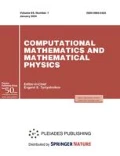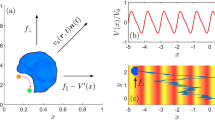Abstract
A mechanism of nanomotor locomotion in a surrounding viscous fluid containing charged particles is considered. In contrast to a mechanism proposed in the literature, according to which nanomotor locomotion is induced by a concentration gradient of certain type particles produced by asymmetric chemical or electrochemical reactions occurring on the nanomotor surface, we hypothesize that nanomotor locomotion can be driven by hydrodynamic interactions in the case of identical concentrations of different-sized ions. To justify the hypothesis, the dynamics of a nanomotor surrounded by a viscous fluid is studied using the diffusion model of electrohydrodynamics and, additionally, the model of a dipolar aggregate surrounded by a cloud of equally but oppositely charged fine particles of different sizes is considered. It is assumed that the total charge of all fine particles is zero and the oppositely charged particles have identical concentrations in the ambient fluid. Computations have confirmed that the nanomotor can move in this case. The direction and speed of the motion depend substantially on both the distribution of the particles in the surrounding fluid and on their sizes. Symmetry breaking in the particle distribution gives rise to a velocity component perpendicular to the dipolar moment direction. In the case of the chemical or electrochemical mechanism of ion formation, symmetry breaking in the ion distribution can be caused by symmetry violations in the nanomotor shape or by possible impurities participating in the reaction, so, to control the nanomotor motion, an external field orienting the nanomotor in the prescribed direction has to be applied. The proposed mechanism of nanomotor locomotion can be used to control mass transfer in colloidal suspensions.




Similar content being viewed by others
REFERENCES
C. Montemagno, G. Bachand, S. Stelick, and M. Bachand, “Constructing biological motor powered nanomechanical devices,” Nanotechnology 10, 225–231 (1999).
W. Gao and J. Wang, “Synthetic micro/nanomotors in drug delivery,” Nanoscale 6, 10486–10494 (2014). https://doi.org/10.1039/c4nr03124e
X. Li, Y.-M. Sun, Z.-Y. Zhang, N.-X. Feng, H. Song, Y.-L. Liu, L. Hai, J.-M. Cao, and G. P. Wang, “Visible light-driven multi-motion modes CNC/TiO2 nanomotors for highly efficient degradation of emerging contaminants,” Carbon 155, 195–203 (2019). https://doi.org/10.1016/j.carbon.2019.08.039
W. F. Paxton, A. Sen, and T. E. Mallouk, “Motility of catalytic nanoparticles through self-generated forces,” Chemistry 11 (22), 6462–6470 (2005). https://doi.org/10.1002/chem.200500167
W. F. Paxton, P. T. Baker, T. R. Kline, Y. Wang, T. E. Mallouk, and A. Sen, “Catalytically induced electrokinetics for motors and micropumps,” J. Am. Chem. Soc. 128 (46), 14881–14888 (2006). https://doi.org/10.1021/ja0643164
Y. Wang, R. M. Hernandez, D. J. Bartlett, J. M. Bingham, T. R. Kline, A. Sen, and T. E. Mallouk, “Bipolar electrochemical mechanism for the propulsion of catalytic nanomotors in hydrogen peroxide solutions,” Langmuir 22 (25), 10451–10456 (2006). https://doi.org/10.1021/la0615950
U. M. Cordova-Figueroa and J. F. Brady, “Osmotic propulsion: The osmotic motor,” Phys. Rev. Lett. 100, 158303 (2008). https://doi.org/10.1103/PhysRevLett.100.158303
T. Vissers, A. van Blaaderen, and A. Imhof, “Band formation in mixtures of oppositely charged colloids driven by an AC electric field,” Phys. Rev. Lett. 106 (22), 228303 (2011). https://doi.org/10.1103/PhysRevLett.106.228303
R. Dreyfus, J. Baudry, M. L. Roper, M. Fermigier, H. A. Stone, and J. Bibette, “Microscopic artificial swimmers,” Nature 437, 862–865 (2005). https://doi.org/10.1038/nature04090
S. Ahmed, W. Wang, L. O. Mair, R. Fraleigh, S. Li, L. A. Castro, and T. E. Mallouk, “Steering acoustically propelled nanowire motors toward cells in a biologically compatible environment using magnetic fields,” Langmuir 29 (52), 16113–16118 (2013). https://doi.org/10.1021/la403946j
B. Robertsona and R. Kapral, “Nanomotor dynamics in a chemically oscillating medium,” J. Chem. Phys. 142 (15), 1063 (2015). https://doi.org/10.1063/1.4918329
V. M. Rozenbaum, M. L. Dekhtyar, S. H. Lin, and L. I. Trakhtenberg, “Photoinduced diffusion molecular transport,” J. Chem. Phys. 145 (6), 1063 (2016). https://doi.org/10.1063/1.4960622
J. L. Moran, P. M. Wheat, and J. D. Posner, “Locomotion of electrocatalytic nanomotors due to reaction induced charge autoelectrophoresis,” Phys. Rev. E 81 (6), 065302 (2010). https://doi.org/10.1103/PhysRevE.81.065302
J. L. Moran and J. D. Posner, “Electrokinetic locomotion due to reaction-induced charge auto-electrophoresis,” J. Fluid Mech. 680, 31–66 (2011). https://doi.org/10.1017/jfm.2011.132
P. Mitchell, “Hypothetical thermokinetic and electrokinetic mechanisms of locomotion in microorganisms, Proc. R. Phys. Soc. Edinburgh 25, 32–34 (1956).
A. I. Zhakin, “Electrohydrodynamics,” Phys. Usp. 55 (5), 465–488 (2012). https://doi.org/10.3367/UFNe.0182.201205b.0495
S. I. Martynov and L. Yu. Tkach, “Mechanism of moving particle aggregates in a viscous fluid subjected to a varying uniform external field,” Comput. Math. Math. Phys. 59 (3), 475–483 (2019). https://doi.org/10.1134/S0044466919030128
S. S. Batsanov, Experimental Foundations of Structural Chemistry (Izd. Standartov, Moscow, 1986) [in Russian].
S. I. Martynov, “Hydrodynamic interaction of particles,” Fluid Dyn. 33, 245–251 (1998).
S. I. Martynov and L. Yu. Tkach, “Simulation of particle aggregate dynamics in a viscous fluid,” Comput. Math. Math. Phys. 55 (2), 282–290 (2015). https://doi.org/10.7868/S0044466915020143
S. I. Martynov and L. Yu. Tkach, “On a model of dynamics of particle aggregates self-moving in a viscous fluid,” Nelin. Din. 12 (4), 605–618 (2016). https://doi.org/10.20537/nd1604005
Funding
This work was supported by the Russian Foundation for Basic Research, project no. 18-41-860002/18.
Author information
Authors and Affiliations
Corresponding authors
Additional information
Translated by I. Ruzanova
Rights and permissions
About this article
Cite this article
Martynov, S.I., Tkach, L.Y. Mechanism of Locomotion of Synthetic Nanomotors in a Viscous Fluid. Comput. Math. and Math. Phys. 60, 1913–1922 (2020). https://doi.org/10.1134/S0965542520110081
Received:
Revised:
Accepted:
Published:
Issue Date:
DOI: https://doi.org/10.1134/S0965542520110081



